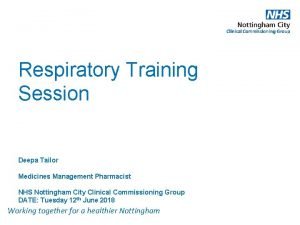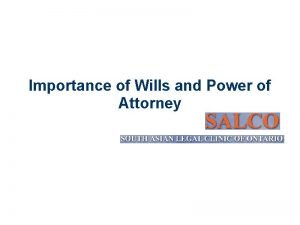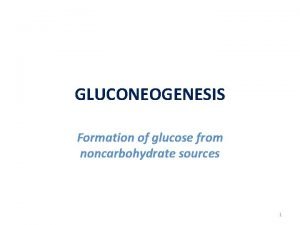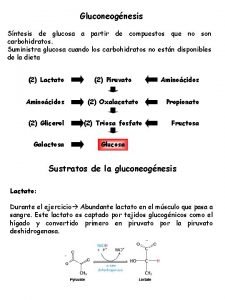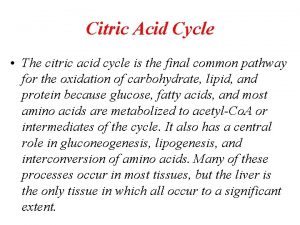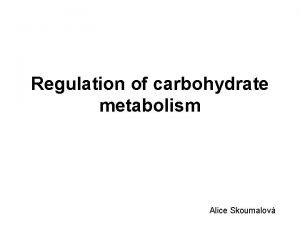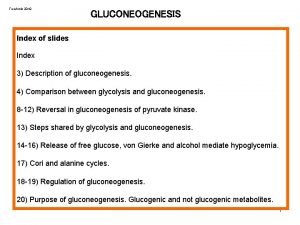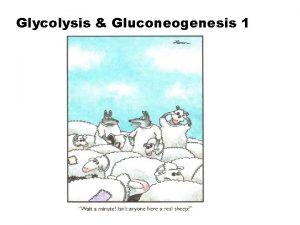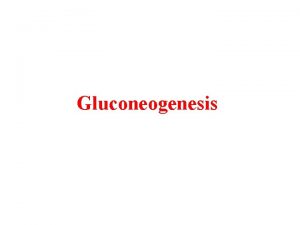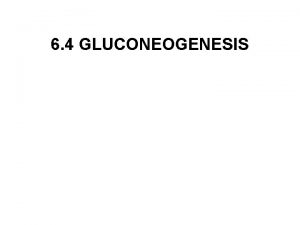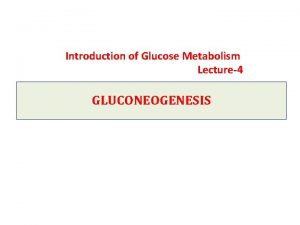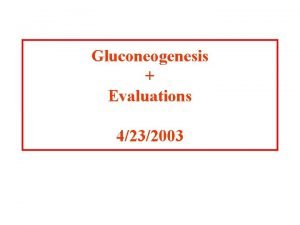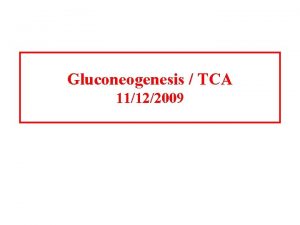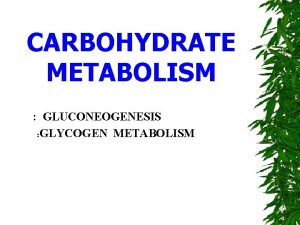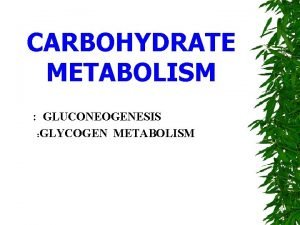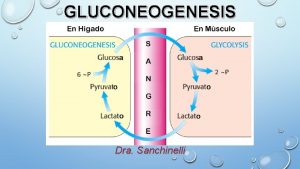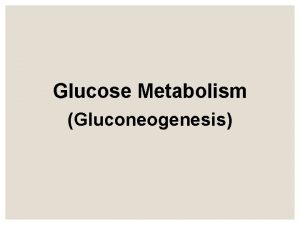GLUCONEOGENESIS Dr Deepa G Muricken Assistant Professor Department










- Slides: 10

GLUCONEOGENESIS Dr. Deepa G Muricken Assistant Professor Department of Biochemistry St. Mary’s College, Thrissur

Glucose Metabolism Glycogen Breakdown Synthesis Pentose phosphate pathway Ribose 5 phosphate Glucose 6 phosphate Glucose Glycolysis Gluconeogenesis Pyruvate Amino acids Acetyl Co A TCA Cycle Gluconeogenesis, Deepa G Muricken, St. Mary’s College Thrissur Fermentation Lactate, Alcohol

Gluconeogenesis • Glucose production from non carbohydrate sources • Prolonged fast leads to hepatic glycogen depletion • Glucose formed from precursors like lactate, pyruvate, glycerol, keto acids • Gluconeogenesis occurs in all animals, plants, fungi and microorganisms • Site of synthesis: • 90% occurs in Liver and 10% in kidney during overnight fast. • Prolonged fasting , kidney become major glucose producing organs. • Occurs in both mitochondria and cytosol Gluconeogenesis, Deepa G Muricken, St. Mary’s College Thrissur

(Continues) q The overall gluconeogenesis pathway reaction is: 2 pyruvate + phosphate + 4 ATP + 2 NADH + 2 H+ → glucose-6 -phosphate + 4 ADP + 4 Pi + 2 NAD+ q The pathway end product, glucose -6 -phosphate, can be converted into other six carbon sugars needed for cell biosynthesis. q Substrates for gluconeogenesis q Glycerol q Released during hydrolysis of triacylglycerols in adipose tissue q Glycerol is phosphorylated to glycerol phosphate by glycerol kinase and oxidized to dihydroxyacetone phosphate by glycerol phosphate dehydrogenase. Gluconeogenesis, Deepa G Muricken, St. Mary’s College Thrissur

(Continues) q Lactate q Released by exercising skeletal muscle and by the cells lack mitochondria q Lactate is taken up by liver and reconverted to glucose by Cori cycle q Aminoacids q Catabolism of glucogenic aminoacids produce pyruvate, α KG, succinyl Co-A, fumarate or oxalo acetate and are precursors of glucose Gluconeogenesis, Deepa G Muricken, St. Mary’s College Thrissur

Unique reactions of Gluconeogenesis ü Among the ten reactions in glycolysis, seven are reversible. These seven reactions are same in both cycles but occur in reverse direction. ü Three irreversible reactions are circumvented by four alternate reactions resulting in synthesis of glucose. ü A. Carboxylation of Pyruvate ü Pyruvate is carboxylated to oxaloacetate by pyruvate carboxylase. Requires Biotin as coenzyme. Reaction occurs in mitochondria ü Pyruvate carboxylase is allosterically activated by acetyl Co A. Gluconeogenesis, Deepa G Muricken, St. Mary’s College Thrissur

(Continues) Activation and transfer of CO 2 to pyruvate , followed by transport of OAA to cytosol and subsequent decarboxylation. Adapted from Biochemistry Lippincott’s Illustrated Reviews Gluconeogenesis, Deepa G Muricken, St. Mary’s College Thrissur

(Continues) B. Transport of OAA to cytosol ü Reconversion of OAA to phosphoenol pyruvate by PEP carboxykinase. This enzyme is found in both cytosol and mitochondria. ü PEP generated is transported to cytosol by specific transporter. ü In mitochondria OAA is reduced to malate by malate dehydrogenase. ü Malate is transported to cytosol since OAA is unable to cross mitochondrial inner membrane. ü In cytosol malate is reoxidised to OAA by cytosolic malate dehydrogenase Gluconeogenesis, Deepa G Muricken, St. Mary’s College Thrissur

(Continues) C. Decarboxylation of cytosolic oxaloacetate ü OAA is decarboxylated and phosphorylated to PEP by PEP carboxykinase. Reaction is driven by the hydrolysis of GTP. ü PEP is acted on by glycolytic reversal pathway until it forms fructose 1, 6 bisphosphate. D. Dephosphorylation of fructose 1. 6. bisphosphate ü This hydrolysis is performed by fructose 1, 6 bisphosphatase and forms fructose 6 phosphate. The enzyme is inhibited by elevated levels of AMP and high levels of ATP stimulate the reaction. ü Enzyme is inhibited by fructose 2, 6, bisphosphate. ü This reaction bypasses PFK-1 reaction in glycolysis. Gluconeogenesis, Deepa G Muricken, St. Mary’s College Thrissur

(Continues) E. Dephosphorylation of Glucose 6 phosphate ü Glucose 6 phosphate is hydrolysed to glucose and surpasses hexokinase reaction by Glucose 6 phosphatase. ü Liver and Kidney are only two organs which release Glucose from glucose 6 phosphate. ü This reaction occurs in glycogenolysis and gluconeogenesis Summary Cleavage of six high energy phosphate bonds and oxidation of two NADH results in formation of Glucose from pyruvate Gluconeogenesis, Deepa G Muricken, St. Mary’s College Thrissur
